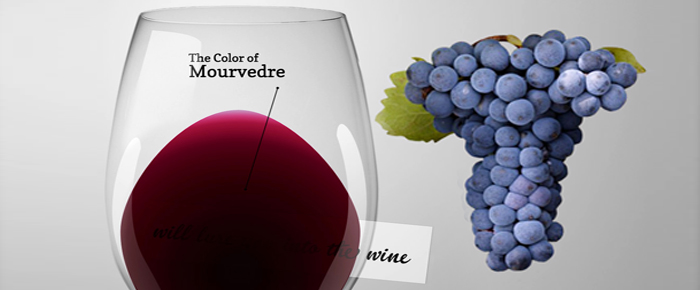
By Rick Riozza
We’ve been covering a slew of refreshing white wines these past few columns; so for those red wine enthusiasts who are a bit jonsin’for a little vino red discourse (really?)—hey, I know, even in our hot desert, red wine is always on the table somewhere and worth any coverage.
Of course in our wide red wine world, no one will seriously wish the Grenache grape/wine to “leave the premises” as we wittingly titled this piece. Indeed, if there is one red varietal that most vino lovers will find agreeable, it’s Grenache!
Everyone loves the full fruit flavors from Grenache. It always satisfies with aromas and tastes of cherries, raspberries, strawberries, spices, herbs, chocolate, and pepper—what’s not to like? You Châteauneuf-du-Pape fans already know there’s always 50 to 70% of Grenache in the world famous blend.
But . . . we’re raising awareness of the Mourvédre [moor-VEHD-ruh] grape, of which you’ve probably enjoyed already because it’s—as with Grenache—a very popular blending grape. One could tell that this grape variety has been around for quite a while because it goes by different names. For you Spanish red wine fans, you’ve come across this grape as Monastrell—with its probable Spanish origins. In Australia and some other parts of the world—yes, even sometimes here in California, it’s known as Mataro.
Speaking of California, it’s been in California soils for more than a century and a half. In parts of Sonoma/Napa and other counties, you’ll find a bunch of old vine Mourvédre in a field/vineyard that’s usually referred to as “black-field blend”, where winemakers of old planted many red wine varietals in one area. The “jug” wine, Hearty Burgundy put out by Gallo back in the 60s, 70s, and 80s (not the current stuff) was a model of “black field blend”—made with Zin, Petite Sirah, Grenache, Mourvédre, and others.
While Mourvédre has its own aroma and palate “profile” such as blackberries, cherries, game, meat, herbs, tobacco, leather, cinnamon, cloves, thyme and other spices, generally the grape has been the “back-up/chorus” to the more known Grenache and of course Syrah. On their own, Grenache and Syrah have always been considered a “loud” wine, if you will: Big fruit and big flavors.
In fact, what is known as the typical “Côtes du Rhône blend” is the triumvirate of Grenache, Syrah & Mourvédre. English language wine labels call this very popular blend simply GSM. And it’s surprising that many wine lovers don’t realize the significance of GSM on the label. They know they’re buying a “red blend”, but perhaps unaware of what the initials stand for.
GSM is no doubt one of the most fruit flavorful wines on earth. It’s one of the perfect “starters” for those getting into the game of wine—not wanting a lot of complexity yet, but wanting to enjoy a “dry” wine that still has plenty of dark fruit to keep you smiling.
A couple of good GSMs recommendations in the “incredibly-low-price” category are the Rabbit Ridge Allure des Robles available at Trader Joe’s, and, Costco’s Kirkland Signature Côtes du Rhône Villages, both at $6.99.
Rabbit Ridge begins with very pleasing aromas of blackberry, blueberry, raspberry, currants, floral notes, vanilla and wintergreen. The medium-bodied wine continues with the same on the palate as well as a bit of added earthiness. Easy to drink and a bit on the sweet side—again, this is a wine for those wishing to begin their wine game’s “dry” wine journey. On the moderately long finish, it turns tart with spicy, peppery notes taking over.
As to the Kirkland Signature Cotes du Rhone Villages, well—I just went out to Costco to purchase a bottle. It’s a youngster, the 2015 vintage, so I decanted it and then poured a glass. It begins with aromas of deep, dark fruit, spice and light earthy notes —much more than you would expect to find on your typical $7 wine. The wine tastes followed the aroma’s perfume, and, it’s light to medium-bodied. Licorice, cedar and spice round things out. It ends dry, earthy, and bit dusty on the long finish. I bet this wine will taste a bit deeper tomorrow.
By the way—only one-fifth of the wine produced in Southern Rhone’s Côtes du Rhône qualifies for the superior designation of Cotes du Rhone Villages. That makes the $6.99 price even bigger news.
In this wine, according to the winemaker, we can discern the Syrah which delivers the deep black fruit concentration and smooth chocolate. Grenache adds balanced harmony, warmth and fruit-forward notes of black plum and blackberry. Mourvédre gives the sense of sweet earth to this classic blend from the Rhone.
What modern winemakers do, notably here in California, is to follow their inventive ideas to produce tasty juice one way or another. Not that a bottle of single-varietal Mourvédre is unheard of, but as we’ve hit hard above, it’s a blending grape! Oops—you’ve got to hate those Freudian slips.
On its own, Mourvédre is very well suited to California’s warm and dry climate. It’s a late-ripener whose flavors are slow to mature; and, it’s not the finicky type—unlike Pinot Noir which requires babysitting. It’s been suggested that this may well be the best surviving grape for global warming.
The good news for the wine enthusiast is that many of the single varietal comes in a little lighter in body and fruit than the single-varietal California Grenache or Syrah wine. That’s sounding as a very likable food wine. Mourvèdre-based wines pair well with grilled and roasted meats, root vegetables, mushrooms and dark fowl such as duck, flavors that harmonize with the earthiness of the wine. Should you have the desire, look for the very fun and tasty 2014 Dirty and Rowdy California Familiar Mourvédre, $30. Cheers!










































